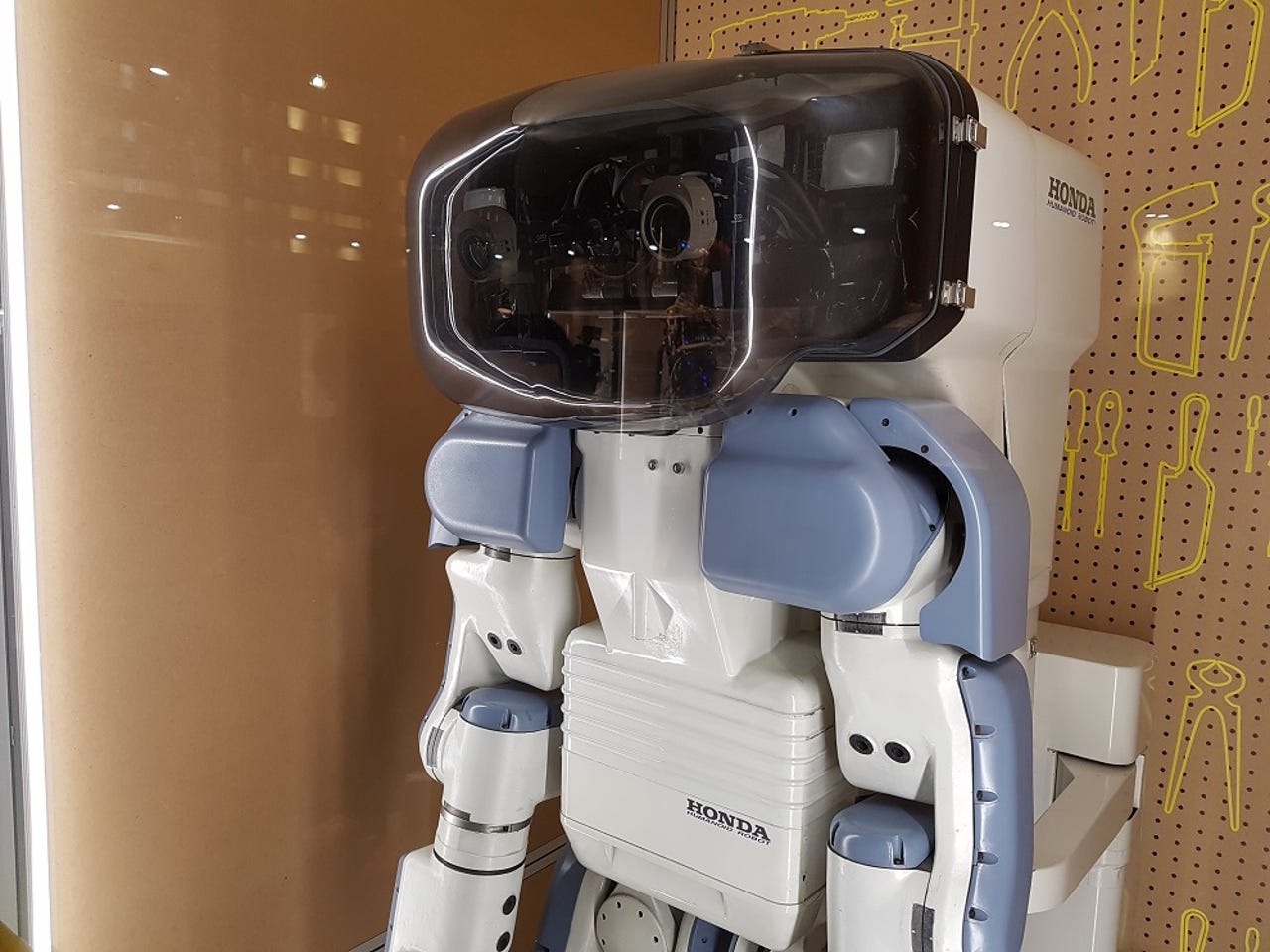Robots: An amazing tour through the biggest collection ever assembled

Robots at the Science Museum
Robots, a new exhibition at the London Science Museum, explores humanity's quest to recreate itself in mechanised form over the course of the last 500 years. It's the most significant collection of humanoid robots to ever be displayed, featuring over 100 robots and examining the past, present, and possible future of robotics.
Animatronic Baby
Visitors to the exhibition are first greeted by a mechanical baby which was commissioned especially for the display. The baby makes pre-programmed movements and noises including, sneezing, breathing, and moving its arms and legs.
Mechanical clocks
Some of the earliest mechanical devices were clocks commissioned by churches and monestaries. These clocks on display in the exhibit are from the 17th century. Ownership of one suggested wealth, status, and an interest in science and the mechanical workings of the universe.
Rose Engine
Designed in around 1750, the Rose Engine produced complex geometrical patterns, cutting them into pieces of wood. This 400-piece object is on display for the first time, having received an extensive restoration.
The intricate design of the golden machine suggests it was made for someone wealthy and it's thought to have been associated with King Frederick the Great of Prussia.
Silver Swan
The Silver Swan is a life-size automaton built by John-Joseph Merlin in 1773 -- and the only one of its kind. Controlled by three separate clockwork mechanisms, the Silver Swan swims, preens, and catches and eats a fish. It has entertained museum audiences for almost 250 years. One famous individual who saw the Swan while it was in Paris was American author Mark Twain, who described it in his travelogue The Innocents Abroad.
The Silver Swan is on loan to the Science Museum from its home at the Bowes Museum at Barnard Castle in County Durham.
Maria
Maria the robot represents one of the very first instances of a robot as we see them today. Maria was designed and built for Fritz Lang's 1927 film Metropolis, now seen as a pioneering work of science fiction. Maria went onto inspire the look of many other robots, including the design of C-3PO in the Star Wars movies. The version of Maria on display at the Science Museum is a replica based on original drawings.
T-800 Endoskeleton
One of the most famous imaginings of a robot in science-fiction, the T-800 Endoskeleton, appeared in the Terminator films. The powerful, almost unstoppable robot is often associated with what could happen if humans don't built controls into artificially intelligent machines.
The Endoskelton robot on display in the exhibit was used in the filming of Terminator Salvation in 2009.
Eric
Originally built in 1928, Eric was Britain's first robot and one of the first working robots in the world. Eric travelled the globe, delivering speeches and firing sparks out of his mouth, before mysteriously disappearing forever. But following a Science Museum Kickstarter campaign, Eric has been rebuilt and brought back to life and is now set for permanent display in his new home at the museum.
George
Built in 1949, George was one of the UK's first humanoid robots, following Eric. George was one of a series of robots built by Tony Sale, a former member of the Royal Air Force who constructed the robot from scrap aluminium. Controlling George relied on Morse code instructions sent from a handheld transmitter. The robot is on loan from the National Museum of Computing at Bletchley Park.
Cygan
Weighing almost 500kg and driven by 13 electric motors, Cygan (left) was built by Dr Piero Fiorito in Italy in 1957. Operated by radio control, Cygan has performed at shows, performing tricks such as dancing and crushing cans. Unfortunately, Cygan eventually found himself unwanted and was left to rust, before being saved and restored to his original condition by a private collector.

Honda P2 - the first
By the 1990s, real science was starting to catch up with science fiction and it was at this time that Honda's P2 prototype literally stepped towards the future. Developed in secret for almost a decade by Honda engineers who conducted studies on human movement to build the robot, the Honda P2 was introduced to the public in 1996. It was the first humanoid robot capable of walking across a room and up stairs.
While the feat was impressive, it took a toll on P2's systems, with the energy required to walk draining its battery in only 15 minutes. It was both a small step and a giant leap for the public face of robotics.
ASIMO
The P2's influence can be seen in ASIMO (Advanced Step in Innovative Mobility), another robot developed by Honda, which is designed to one day interact with and help people. Regarded as one of the world's most advanced humanoid robots, no other current machine in such a small package matches ASIMO for agility and intelligence.
Nexi
With its big eyes, Nexi by Personal Robotics Group is an expressive robot which is used to study human behavior. Nexi's arms, hands, head, and 21 facial features are computer controlled and used by researchers to observe how people react to its expressions and body language in different situations.
Harry the trumpet-player robot
Some robots are designed to perform a specific task. One is example is Toyota's Harry, the first walking humanoid robot. Launched in 2005, Harry represented Toyota commitment to robotics and to promoting the concept of intelligent and caring robot assistants.
Harry was designed to authentically play the trumpet, a task which requires multiple skills including the use of dexterous fingers flexible lips and 'breath'. It was a complex feat for Toyota after just five years in the robotic arena.
Baxter
First built in 2015, Baxter was the world's first two-armed robot designed to work alongside people. There are two different versions of Baxter: one designed for manufacturing tasks in factories and a second for use in assisting laboratory research.
In both cases, people can train Baxter by guiding its arms and grippers into the required positions and teaching it the required actions. Baxter is capable of directing its gaze towards the action it is attempting to perform, and even has pre-programmed facial expressions to show its state of operation. Over 3,000 units have been sold so far.
Yumi IRB
Robots are increasingly capable of carrying out intricate tasks. One of those is YuMi IRB. Designed for assembling electronic, medical, and other small devices which require careful handling, YuMi has such a delicate grip, it's even capable of folding paper without damaging it. Unlike traditional industrial robots which are large and potentially dangerous, YuMi can work at the same table as a person without the risk of it doing harm.
Human Support Robot
Not only do robotics researchers want to develop robots for use in the workplace, they also want to create robots which provide help and care for people. Built by Toyota in 2012, this Human Support Report is designed to run simple errands and connect its users with their carers. A newer model is currently being trialled by research groups for use with hospital patients.
Kaspar
Children with autism can find it difficult to read other people's facial expressions, emotional states, and interpret their behaviour. Kaspar is designed to help autistic children with games where they can learn about communication and interaction with others in order to build confidence.
Kaspar can talk, comb its hair, bruth its teeth, play the drums, sing, name parts of the body, and more. The robot, designed by the University of Hertfordshire, can help children understand cause and effect and understand physical contact. For example, if Kaspar is treated roughly, it will react and ask the child to be gentle.
REEM
Robot butlers are as much a staple of science fiction as emotionless killing machines. One real-life service robot is REEM.
Built by PAL Robotics, REEM is designed to work in human environments and freely interact with people. It has been used as a receptionist, guest greeter, master of ceremonies, and visitor guide.
Visitors to the Science Museum's Robots exhibition will see REEM moving about the gallery and will be able to interact with it via a touchscreen to find out more about robotics.
Kodomoroid
In many cases, robotics developers tend to steer away from making their creations look too lifelike, as it can be off-putting and unsettling to people. However, Hiroshi Ishiguro Laboratories wants to make androids as realistic as possible -- such as this robot, named Kodomoroid.
Kodomoroid was designed to read out news stories to visitors at the Japanese National Museum of Emerging Science and Innovation. Its stay at the London Science Museum represents its first extended appearance outside Japan. While in London, it will read out recent news stories to visitors as it did back home.
RoboThespian
The first full-sized humanoid robot to be commercially produced, RoboThespian, is built with communication and entertainment in mind. This robot can react to members of the public and customises its responses depending on the age and gender of who it is speaking to.
Built by Engineered Arts, RoboThespian has starred in films and plays, performed stand-up comedy, and even officiated a wedding in China. Could it eventually lead to a 'winter of discontent' for human actors?
Robots on Tour
The Robots exhibition at the London Science Museum is open now and runs until 3 September 2017. After that date, the exhibition will embark on a UK tour, visiting the Manchester Museum of Science and Industry from 19 October 2017 to 15 April 2018, and then the Life Science Centre in Newcastle from 26 May 2018 to 2 December 2018.
Robots will then move to the National Museum of Scotland in Edinburgh from 18 Jan 2019 to 12 May 2019, before leaving the UK to tour the world.